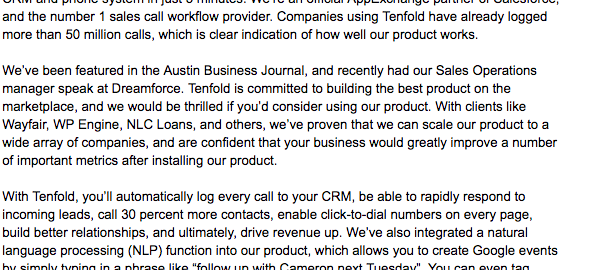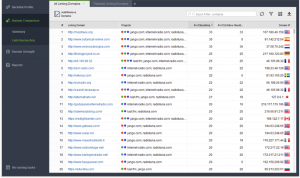Cold emailing is a practice that a number of companies and individuals adhere to, and it’s easy to see why. You can reach a significant number of people all at once with the click of a button, and do so in a way that very clearly communicates what your company does, and why prospects should care.
In theory, cold emailing can be a fantastic tool for marketers and salespeople alike, but only if they carefully put together their message.
Often times people don’t place the necessary attention on cold emailing that it desperately needs, and in the process, they make a serious misstep. Whether that’s a failure to correctly brand your company or an inability to use templates correctly, there are more than a few ways to ruin your cold emailing outreach before ever sending it to anyone.
As such, below are five common mistakes that people make when cold emailing.
1. You’re emailing the wrong person
If in the process of sending someone a cold email, you happen to contact the wrong person, good luck getting them to pass along the information to the right decision maker. People are constantly inundated with unwarranted emails, and if they receive a message that doesn’t pertain to them, they’ll either ignore it, or send it to the trash.
That’s why it’s vital to have one simple sentence in all of your outreach emails. They don’t have to mirror exactly what’s below, but it should accomplish the same goal.
“If you’re not the right person I should reach out to, could you point me in the right direction of who I should contact?”
This is short, and to the point; and most importantly, what you’re asking isn’t complicated. More often than not, people will forward along your request, or respond with the right point of contact; but even if that doesn’t happen, by inserting that question into your outreach, you’ve built in a reason to follow up.
2. Your cold email is too long
When conducting cold email outreach, it’s essential to remember that what you’re doing is sending someone an unsolicited email; so make sure to get to the point quickly. This is a cold email, not a presentation to the shareholders of the company.
The group that you just messaged likely doesn’t know you or your company, and frankly they don’t want a detailed run-down of all the applications and benefits of your product. Keep your first email short and sweet. It shouldn’t take more than 15-20 seconds to read. Tell them who you are, what your company’s main function is, and why you’re reaching out.
Imagine getting the following message.

Nobody wants to read that email. It looks like an abstract to an incredibly long article rather than a cold email. Instead, it should appear as follows.

The first email (which is terrible), takes nearly one minute to read, whereas the second example takes just more than 15 seconds. Both convey the same overall idea, yet one is drastically better than the other. Make sure to follow the latter template when it comes to cold emails.
3. Your cold email is clearly automated
Cold emails are tricky because the goal is to reach as many people in as little time as possible; which is where email templates come into play. With the click of a button, you can send a slightly customized email to people; but in reality, that customization is nothing more than mentioning their name, their company, and possibly where they’re located.
It’s easy to spot emails like this, and they immediately turn people off; which is why you need to be careful when constructing your templates. One way to make them feel more personal is to keep them short and sweet, as there are fewer opportunities to mention boilerplate topics.
The worst case scenario: Your email automation failed and you just sent a template to hundreds of people
While email template can be a good thing when used correctly, they can also sink your entire outreach efforts with one simple screw-up. Take this for example.

It’s almost shocking how frequently an email like this will wind up in someone’s inbox. It might not be the death knell for your outreach, but it certainly isn’t a good way to start off a relationship. If this happens, turn it into an opportunity and send a follow-up email bemoaning how clumsy you can be with email templates.
4. Failing to follow up
If, at first, your cold email doesn’t succeed, try and try again.
During your prospect outreach, it’s likely that a number of people are going to be interested, but for a number of reasons, will simply fail to respond. You could craft the perfectly engaging email, filled with actionable data that will entice your prospects, but if you catch them at the wrong time of day, or at a particularly busy period of their lives, they might forget to reach out.
This is why it’s vital to send at least one follow-up email, if not more.
Help yourself by scheduling a follow up reminder (with a tool like Yesware) and write quick and short follow ups.
Don’t just repeat your pitch like a robot in your follow up emails. Instead, try to ask for a good alternative time to grab a call, or even give the prospect something of value that builds up your credibility (a free e-book or a link to your newest blog post for example.)
5. Talking down to your prospects
This is one of the biggest mistakes you can make. Sure, sending an unfinished template is embarrassing, and emailing the wrong person is awkward, but talking to your prospects like a five-year-old could have serious consequences; for you and your company. When trying to make clear and concise points, people will often simplify their language, and ask “easy questions.”
How would you feel getting the following line of questioning in an unsolicited email?
“Do you like increasing revenue? Do you like making more money? Do you like having more freedom at your job?”
Anyone with a brain is going to answer “yes” to all of those questions. Who doesn’t like making more money and having more freedom? There’s no point to asking these because anyone worth talking to is going to have the same answers. It’s condescending and immediately sends the wrong message to your prospects.
Conducting cold email outreach can be a powerful tool, but only if it’s done with great attention to detail. Remember to keep your message clear and concise, and to inject some personality into your email templates. Avoiding the pitfalls mentioned above could very well be the difference between connecting with a prospect and never hearing back.
Digital & Social Articles on Business 2 Community(150)






